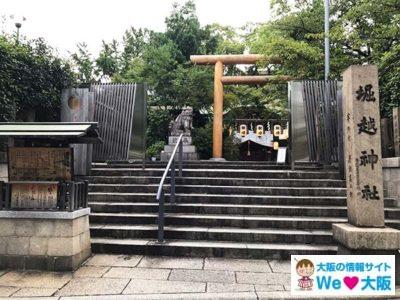A tour of the brewery within walking distance of the station. Daimon Shuzo is a sake maker from Katano city that is popular overseas.
2019.10.02
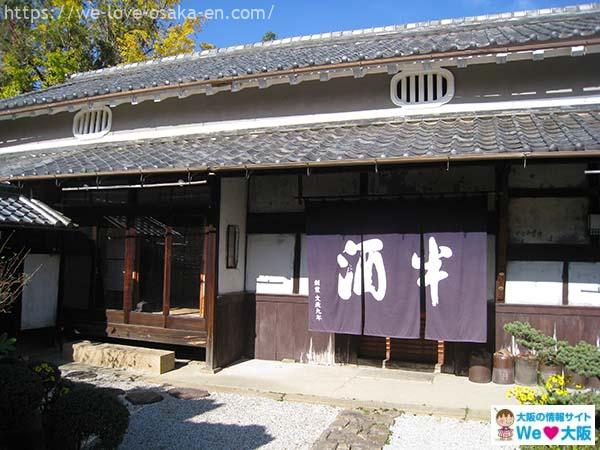
Japanese sake is getting popular all over the world. According to statistics of foreign trade issued by Ministry of Finance, the export volume of refined sake in 2017 increased by 19% compared to the previous year, and it has been making a new record for 8 years consecutively. Domestically, they are expanding its fan base to women. This trend has made sake brewery tours very popular.
Speaking of Japanese sake, Nada in Kobe and Fushimi in Kyoto are very popular, but There are sake breweries in Katano in Osaka, which are located along Keihan line.
Japanese sake is made from rice and water, and people have cultivated rice in Katano since Yayoi Era, and the soil was so rich that it was said that rice grows only by dropping seeds.
Katano also has access to good water, especially that of Mount. Kongo-Ikoma. This location has allowed Katano and regions around it to have sake breweries in Edo Era.
Here, we are going to take a look at a sake brewery tour. This article will introduce a tour at Daimon sake brewery tour, which is easily accessible, located within walking distance from stations. Daimon sake brewery is an eight-minute walk away from the closest station but it is hard to find, so here many pictures are used to make it easy for you to understand.
In addition, this article introduces what I heard in the tour so that you will find this paid tour worth joining.
If you want to go on sake brewery tours but you are a little anxious, you should take part in on here at Daimon sake brewery.
目次
1.What is Daimon sake brewery like?
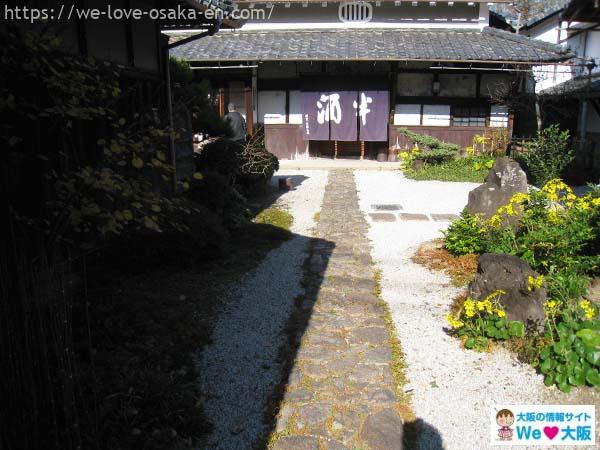 It was founded in 1826, and since then this brewery has been making Japanese sake in Katano for over 190 years. It does business as “酒半,”(Saka Han) and it was named after its founder 半左衛門喜之. They have been exporting overseas recently, and sometimes they hold tours in English. I saw people from overseas when I took part in the tour.
It was founded in 1826, and since then this brewery has been making Japanese sake in Katano for over 190 years. It does business as “酒半,”(Saka Han) and it was named after its founder 半左衛門喜之. They have been exporting overseas recently, and sometimes they hold tours in English. I saw people from overseas when I took part in the tour.
2.What does sake brewery look like?
It’s hard to imagine what they look like. Daimon sake brewery makes sake in a historical building that has been renovated, not in a factory as you might imagine.
Lumber is used for joists for its ceiling, but each piece is different in shape, so each of them is used in places suitable for them. The inside of the building is kept very clean as sake is produced here.
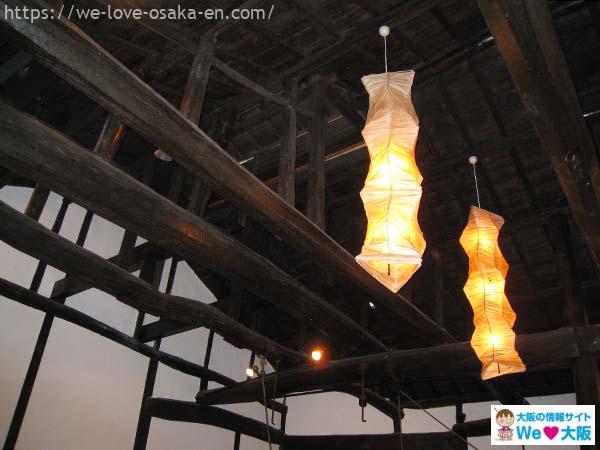
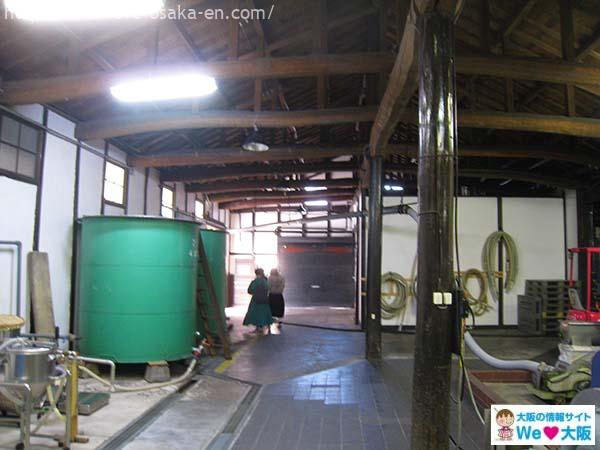 It is cool inside in summer but it can get very cold in fall and in winter. I participated in a tour on a sunny day in November, but the tips of my feet got chilled after sitting for 30 minutes in there. If you want to go on a tour, you may want to wear clothes that keep the tips of your feet warm.
It is cool inside in summer but it can get very cold in fall and in winter. I participated in a tour on a sunny day in November, but the tips of my feet got chilled after sitting for 30 minutes in there. If you want to go on a tour, you may want to wear clothes that keep the tips of your feet warm.
3.Access to Daimon sake brewery
From Kyobashi, you can take a limited express train, get off at Hirakatashi Station, change lines to Katano line, get off at Kawachimori Station, and walk for about eight minutes from there.
If you were to visit Daimon sake brewery from Yodoyabashi, you can get to Kawachimori Station in about 30 minutes (excluding time to change trains), and it takes within one hour including the walking part.
3-1.How you change lines to Katano line at Hirakatashi Station
You will get off on track No.1 and No.2 at Hirakatashi Station when you come here from the direction of Yodoyabashi and Kyobashi. To change lines to Katano line, take the stairs down of the platform, and go upstairs to track No.5 and No.6(If you come here from the direction of Kuzuha and Kyoto, you will get off on track No.3 and No.4)
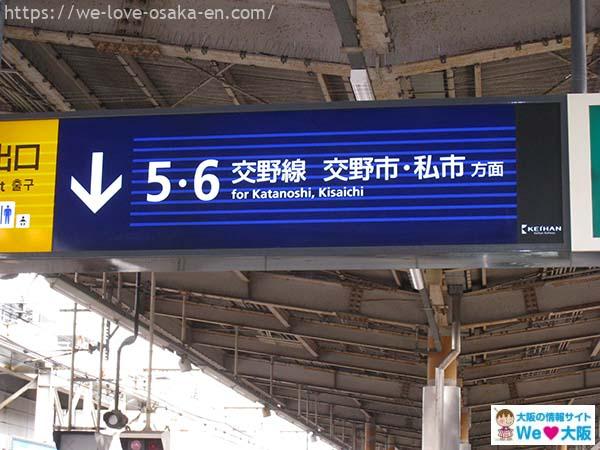 There are signs that lead you to Katano line at the stairs, so you don’t have to worry.
There are signs that lead you to Katano line at the stairs, so you don’t have to worry.
You can take any stairs to go to track No.5 and No.6, but here I will tell you how you go from the stairs on the Osaka side. Once you go down the stairs, you make a left. There are signs here as well, but if you don’t know the way to Katano line, you can always ask a station staff at ticket gates and they will kindly tell you the way.
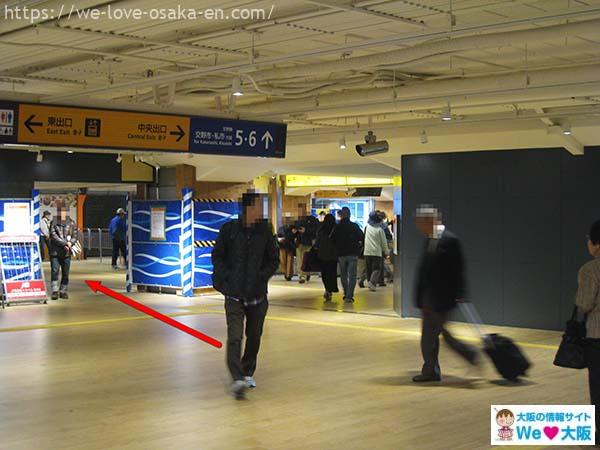 There is a sign for Katano line when you go left.
There is a sign for Katano line when you go left.
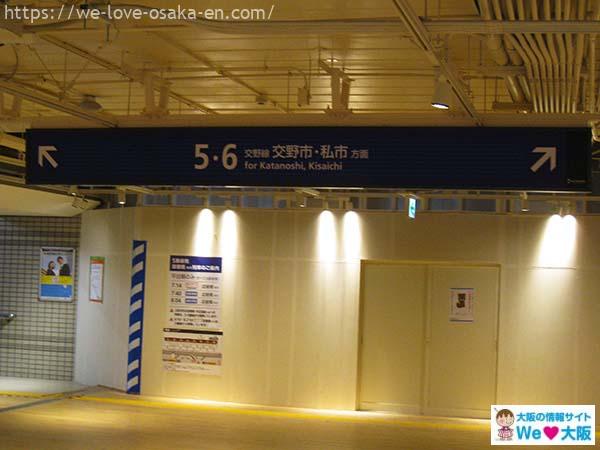 The trains on Katano line are local trains and are all going to Kisaichi Station, which is the final stop of the line. They are conductorless and there are no station staff at the platform except for rush hours, so you have to ask the motorman if you have questions.
The trains on Katano line are local trains and are all going to Kisaichi Station, which is the final stop of the line. They are conductorless and there are no station staff at the platform except for rush hours, so you have to ask the motorman if you have questions.
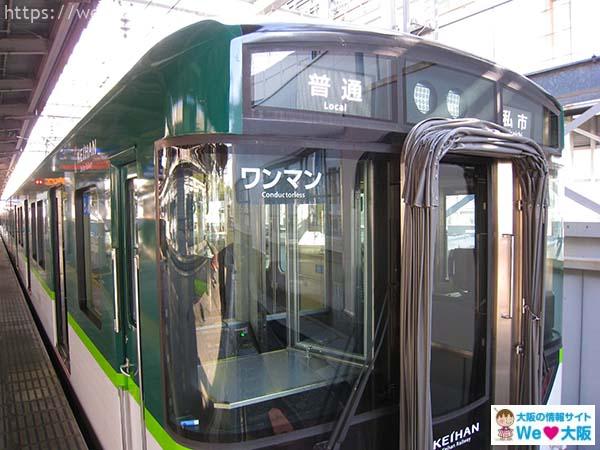
3-2.Get off at Kawachimori Station
The closest station to Daimon sake brewery is Kawachimori Station. This station is the one before Kisaichi Station. You should get on one of the train cars in the middle.you can take the escalator to go down at Kawachimori Station.
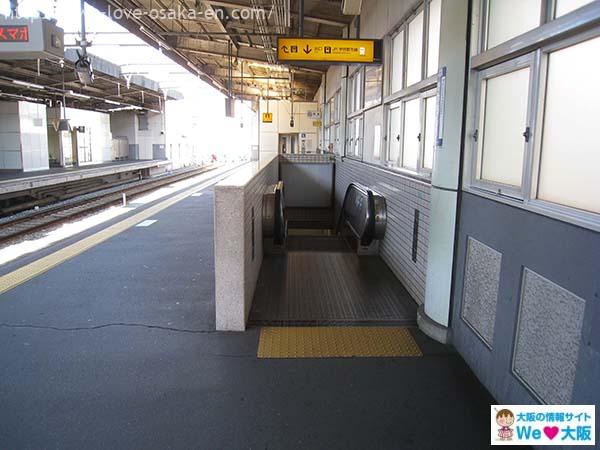 You will find the ticket gates when you go down the escalator. These are the only ticket gates of this station. Then take the escalator up you see on the right.
You will find the ticket gates when you go down the escalator. These are the only ticket gates of this station. Then take the escalator up you see on the right.
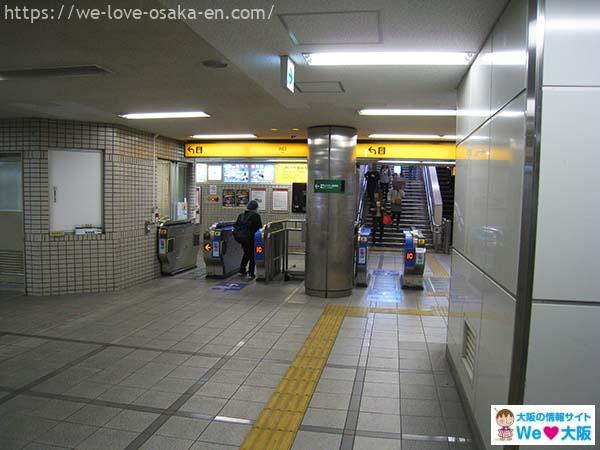 Once you take the escalator up, you will see a road in front of you, so take a right.
Once you take the escalator up, you will see a road in front of you, so take a right.
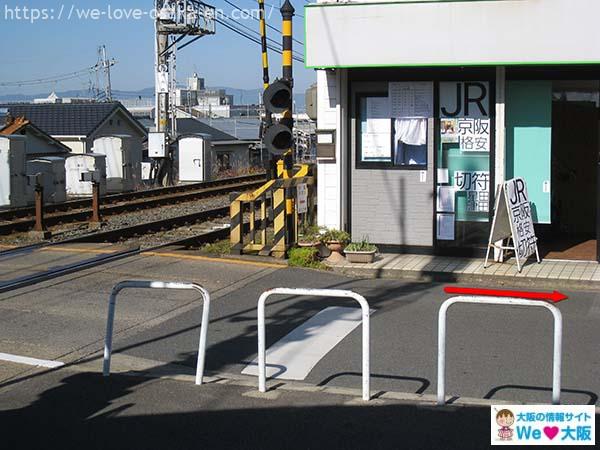 You will be here after you take the escalator, so make a right, the opposite direction to the railroad crossing.
You will be here after you take the escalator, so make a right, the opposite direction to the railroad crossing.
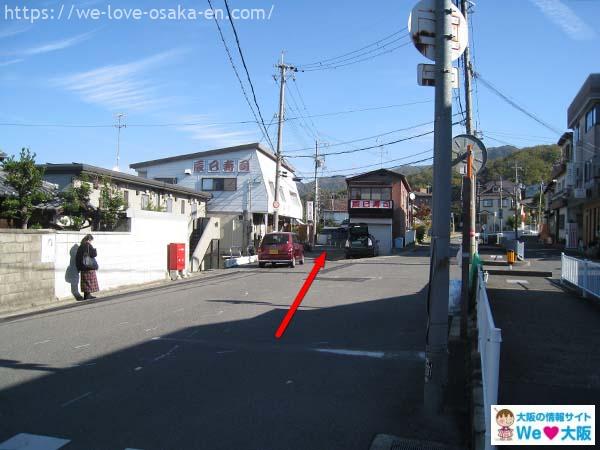 When you turn left, you’ll see the “JA Kitakawachi” building on your right.
When you turn left, you’ll see the “JA Kitakawachi” building on your right.
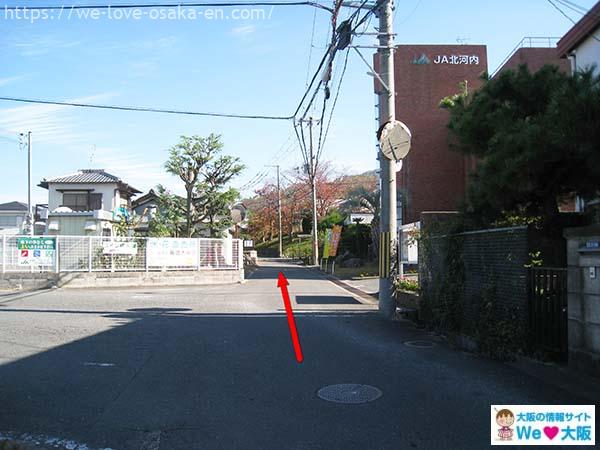 Go straight in the direction that the arrow points to, and you will see the sign of Daimon sake brewery on your left.
Go straight in the direction that the arrow points to, and you will see the sign of Daimon sake brewery on your left.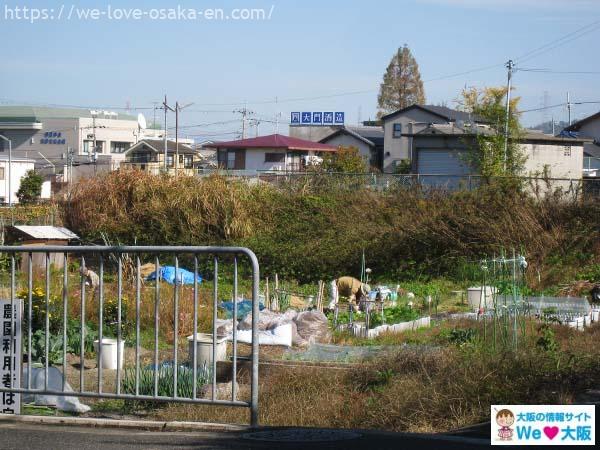 There is a place where the road becomes narrow suddenly when you walk, but you also go straight here.
There is a place where the road becomes narrow suddenly when you walk, but you also go straight here.
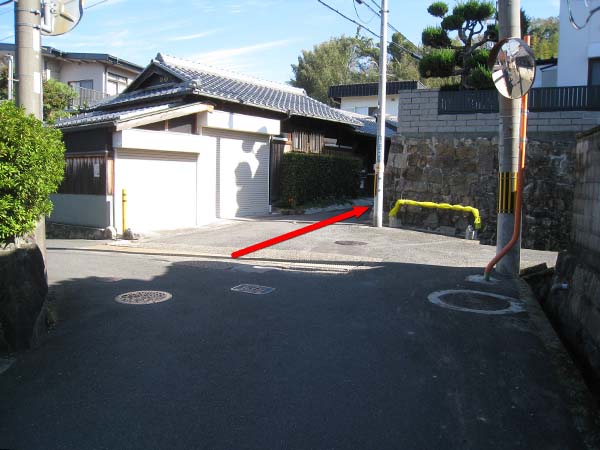 Turn left when you see the stone lantern on your left.
Turn left when you see the stone lantern on your left.
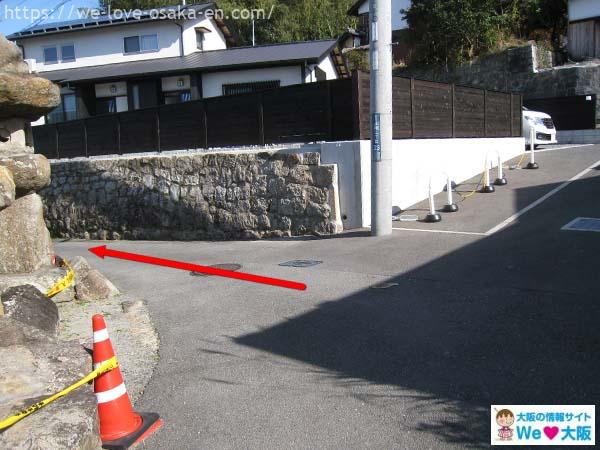 Don’t get close to the stone lantern because 2018 Osaka earthquake on June 8 and Typhoon No.21 that hit on September 4 destroyed part of it. (As of November 18, 2018)
Don’t get close to the stone lantern because 2018 Osaka earthquake on June 8 and Typhoon No.21 that hit on September 4 destroyed part of it. (As of November 18, 2018)
You might miss where you made a left on your way back. Again, this stone lantern is the guide.
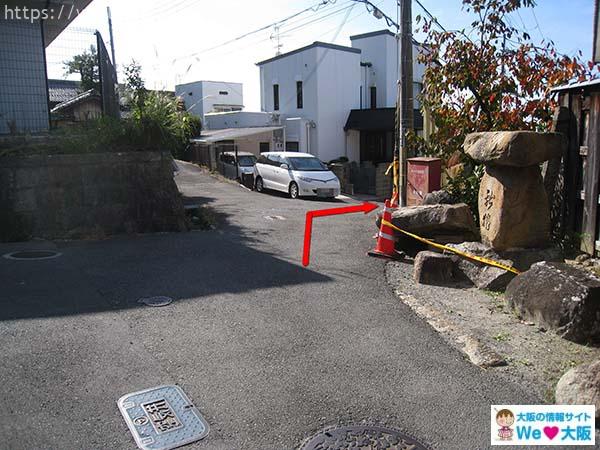 You will find a narrow path that cars cannot go along, but it is a quaint scenery.
You will find a narrow path that cars cannot go along, but it is a quaint scenery.
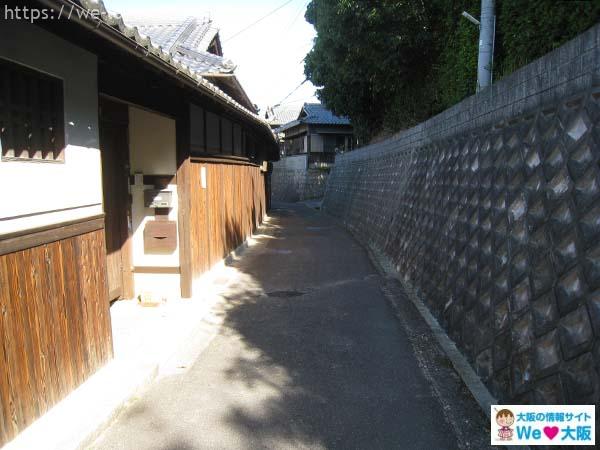 You will see gates with a sign that says “酒屋半左衛門”(Sakaya Hanzaemon) on your left, and you will see a store curtain that says “酒半”(Saka Han). This is where you enter Daimon sake brewery from.
You will see gates with a sign that says “酒屋半左衛門”(Sakaya Hanzaemon) on your left, and you will see a store curtain that says “酒半”(Saka Han). This is where you enter Daimon sake brewery from.
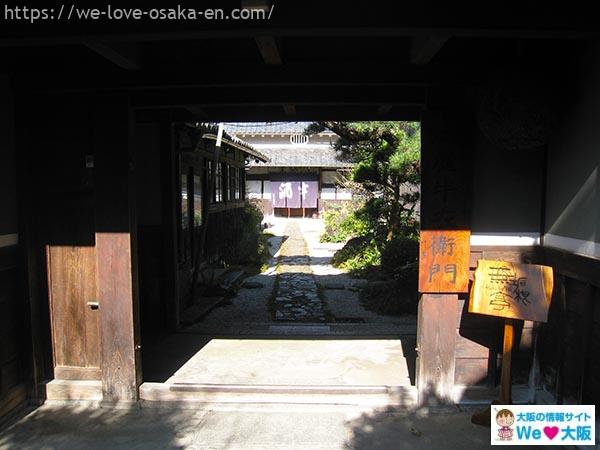 After you enter this gate, you will see a sliding door entrance on your right, where you book a tour.
After you enter this gate, you will see a sliding door entrance on your right, where you book a tour.
4.What you can do on the tour
The contents of the tour are the following,
・Explanation of sake production
・Sake brewery tour
・Tasting
First Mr. Daimon, who is the director and the president of Daimon sake brewery, will explain about sake production, history of Daimon sake brewery, and history of sake production in Katano.
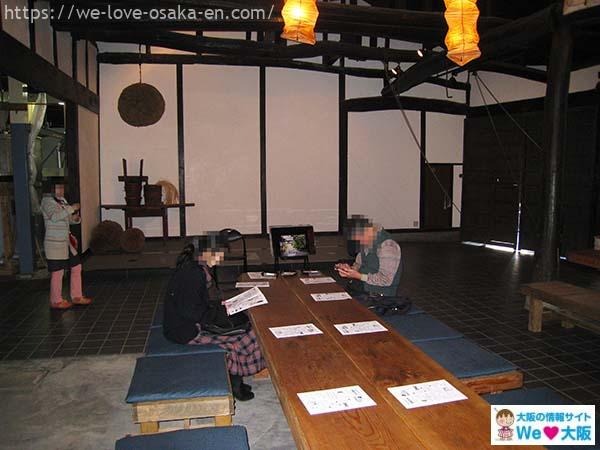 The explanation is offered inside this room. On the day I visited here, there were eight participants including men and women at various ages. Recently the number of young women who drink Japanese sake has been increasing, so I saw some young women on this day.
The explanation is offered inside this room. On the day I visited here, there were eight participants including men and women at various ages. Recently the number of young women who drink Japanese sake has been increasing, so I saw some young women on this day.
4-1.Content of the explanation
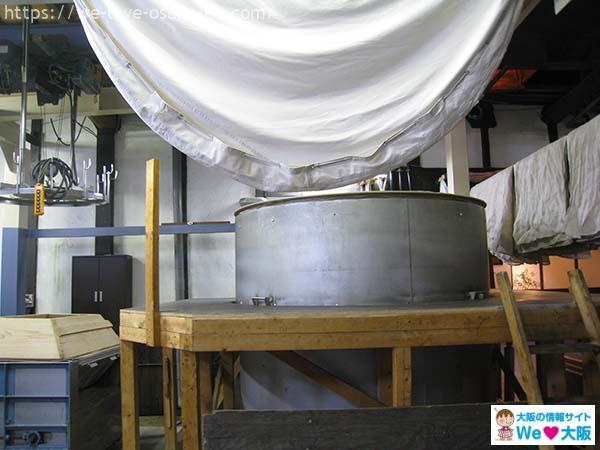 You will hear the process of sake production and stories about Japanese sake. The machine in the picture is used in Japanese sake production.
You will hear the process of sake production and stories about Japanese sake. The machine in the picture is used in Japanese sake production.
There are roughly 11 processes in the production process of sake.
1. Rice Milling
2. Rice Washing
3. Rice Soaking
4. Rice Steaming
5. Koji Making
6. Shubo
7. Moromi
8. Pressing
9. Filtration
10. Storage
11. Bottling
You may not be familiar with the terms, but manga texts distributed here will help you understand the role and the details of each process. For example, in the process of rice soaking, rice is immersed in water to let it soak up water. They soak rice called Yamadanishiki, which is used in sake production, for about seven and a half minutes. No fine sake can be made if soaked in a shorter nor longer period. This time varies by the kind of rice.
Wine as well as Japanese sake is made by fermentation, but wine production has much less processes. You will know why in the explanation.
Time and temperature are set strictly in other processes, which shows how sensible Japanese sake production is.
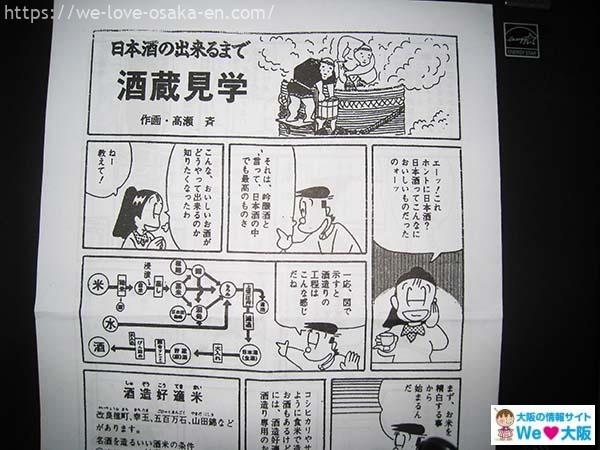 The stories about Japanese sake include.
The stories about Japanese sake include.
・Story about water and rice
・The transition of the taste of Japanese sake
・The difference between rice used in sake production and rice eaten everyday
・What Ginjo sake is
・The difference between Jozo sake and Ginjo sake.
He explains how important rice and water is for sake production, and as I said above, how water characterizes sake. It might be hard to understand for those who do not like Japanese sake that much, but recently Japanese sake called Tanrei-karakuchi, which tastes cricp and dry, is very popular. Since several years ago, not only Tanrei karakuchi, but also sweet and rich sake is also well-liked.
You might be familiar with the term Ginjo sake, but what is it like? They will answer this question as well. Ginjo sake is defined by two factors, and one of them is rice-polishing ratio.
To make Ginjo sake, the rice-polishing ratio needs to be below 60%. The rice-polishing ratio is how much rice is polished. It is hard to imagine the rice-polishing rate of below 60%, but you can see the polished rice on the tour.
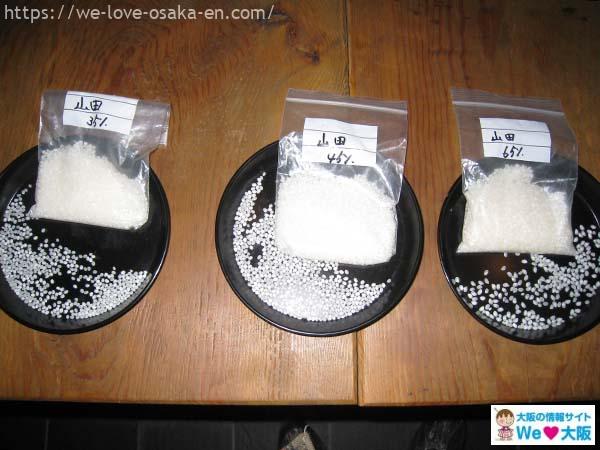 You will be surprised to see how small they are if you take a look, though it is hard to see in the picture.
You will be surprised to see how small they are if you take a look, though it is hard to see in the picture.
You may find it difficult to understand if you read it, but the president’s way of talking is detailed and very understandable, so you will not find it difficult at all. The participants were earnestly listening to him, looking at the text.
The explanation will take approximately 30 minutes. After that you will see the brewery with the president.
4-2.Brewery tour
The tour of the brewery follows the manufacturing process of Japanese sake.
This one is rice washer. I could not see this machine operating on the day, but they use jet streams of water to wash rice flour off of the surface.
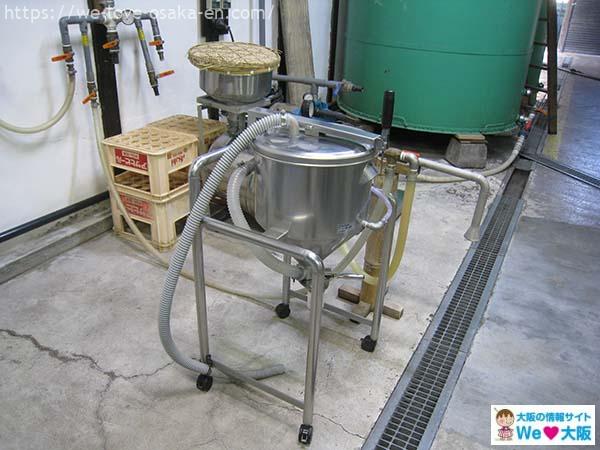 The next one is the machine in which rice is immersed in water, in the first step of sake production.
The next one is the machine in which rice is immersed in water, in the first step of sake production.
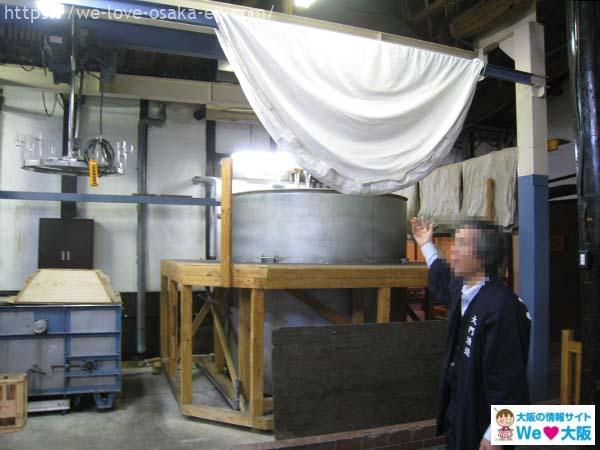 On the tour, you will go along the processes of the sake production with the president explaining each step.
On the tour, you will go along the processes of the sake production with the president explaining each step.
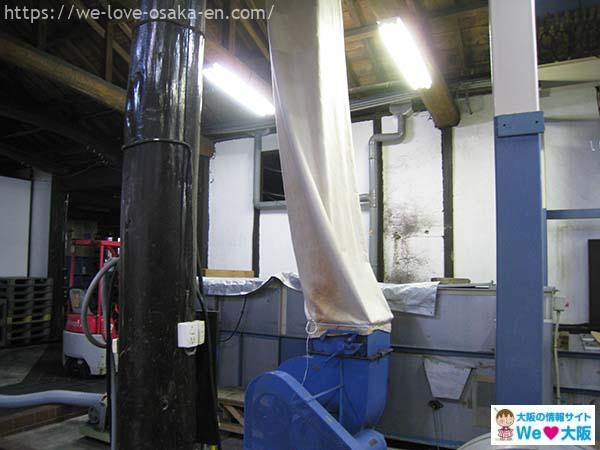 This is the steamer, with which they steam rice. They steam rice for about 50 minutes, and this softens starch of rice, helping koji mold propagate itself, which plays an important role in Japanese sake production.
This is the steamer, with which they steam rice. They steam rice for about 50 minutes, and this softens starch of rice, helping koji mold propagate itself, which plays an important role in Japanese sake production.
The rice steamed here can be divided into three categories: one is for koji mold, another one is for shubo, and the other is for moromi. Koji production is done by sprinkling koji over steamed rice.
This might seem simple, but the koji production takes two days and nights, 50~55 hours at longest, 45 hours at shortest. This time is determined based on what they want the sake to taste like eventually.
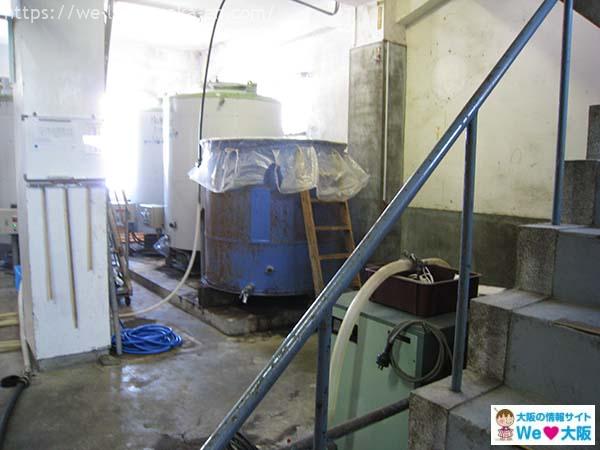 This is shubo tank. They pour water, koji, and pure yeast fungi, and steamed rice, and they make moromi. It takes about 15 days. Moromi is the process for alcoholic fermentation.
This is shubo tank. They pour water, koji, and pure yeast fungi, and steamed rice, and they make moromi. It takes about 15 days. Moromi is the process for alcoholic fermentation.
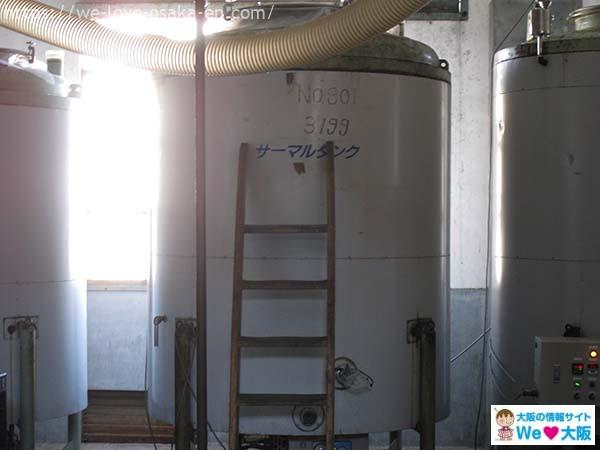 This is the thermal tank. Thermal is a tank with cooling function. Once they get yeast fungi, they put moromi in this. The reason why this tank has cooling function is because they can stop the process of fermentation at the optimal moment by cooling the tank, and without it the fermentation continues.
This is the thermal tank. Thermal is a tank with cooling function. Once they get yeast fungi, they put moromi in this. The reason why this tank has cooling function is because they can stop the process of fermentation at the optimal moment by cooling the tank, and without it the fermentation continues.
Then when do they stop the fermentation? They will explain this as well on the tour. Also you can hear about things you can hardly hear, such as what they do during the process.
When they put moromi into this tank, they put a third of it and they do this three times. This is called “sandan-shikomi.” Sandan-shikomi takes four days, and you will hear why it takes that much time and how they add moromi each time. The whole process, though it depends on the kind of sake, takes from 24 to 35 days. You can hear interesting stories such as the director’s work and difficulties they have in this process.
In the pressing process, they press moromi, separating sake from sakekasu (sake lees)
4-3.Tasting
After the tour, we can enjoy tasting some of the Japanese sake. We move to another room where we can try Japanese sake after the president explains how the sake production goes.
This time we tried two kinds of DAIMON series, and four kinds of Rikyu Ume series, six kinds of sake in total.
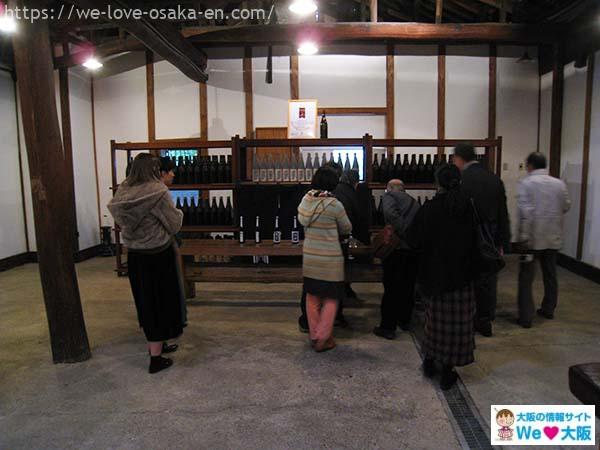 You can try the sake in the brewery. We call it tasting here at the tour of Daimon brewery.
You can try the sake in the brewery. We call it tasting here at the tour of Daimon brewery.
It is not just comparing different kinds of sake and see which one is your favorite and which one if your least favorite one, but you will taste each sake, judging each sake based on their sweetness, impression, and acidity. So, it is not just “trying” each sake, but you will be “tasting” each sake.
The participants choose different kinds of sake as their favorite every time. You can taste the difference of each sake, because you will not only choose which one you like or don’t like, but also judge, for example, which one is sweet but rich, and which one is crisp but too light.
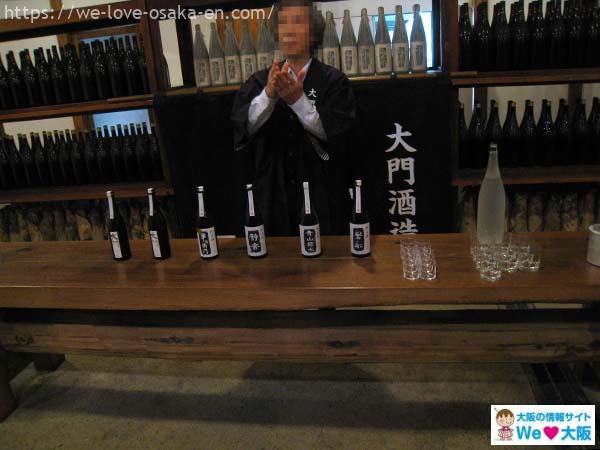 This time they had six kinds of sake but the participants chose different kind of sake as their favorite, regardless of the price, how they are made like if they are Daiginjo or Junmai sake.
This time they had six kinds of sake but the participants chose different kind of sake as their favorite, regardless of the price, how they are made like if they are Daiginjo or Junmai sake.
After you learn how you taste each sake, you will be able to know which sake is your favorite one.
My favorite sake is this one. I don’t often drink Japanese sake, but I liked this so much that I bought this one.
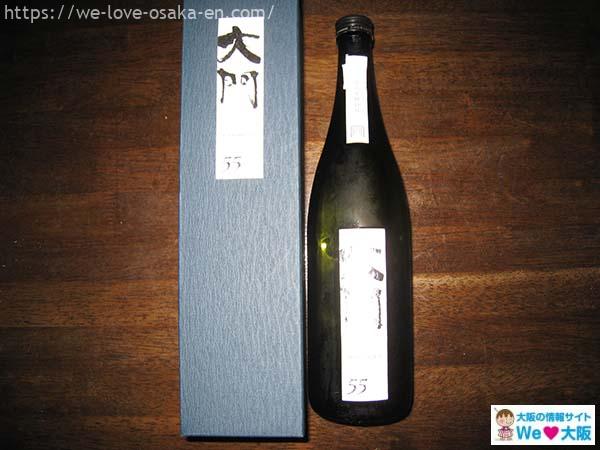 Sorry I couldn’t help drinking before I drank it.
Sorry I couldn’t help drinking before I drank it.
This is the end of the whole tour. It took about an hour. You will learn where Japanese sake is produced, and a new way you can enjoy Japanese sake.
5.5 senses of taste that determine the taste of Japanese sake
The taste of Japanese sake can be divided into two tastes, sweet and dry. However, Japanese sake has five tastes.
・Sweet
・Sour
・Dry
・Bitter
・Astringent
It’s counterintuitive that bitter and astringent tastes are important for Japanese sake, but they are very important for constituents of their taste.
If the sake is not bitter nor astringent, Japanese sake will not be rich. If they are too bitter or too astringent, they would not taste good, but the balance of the five tastes is very important.
So, if you pay attention to the five tastes, the Japanese sake is more interesting.
6.Can you buy sake?
You can buy it where you book a tour.
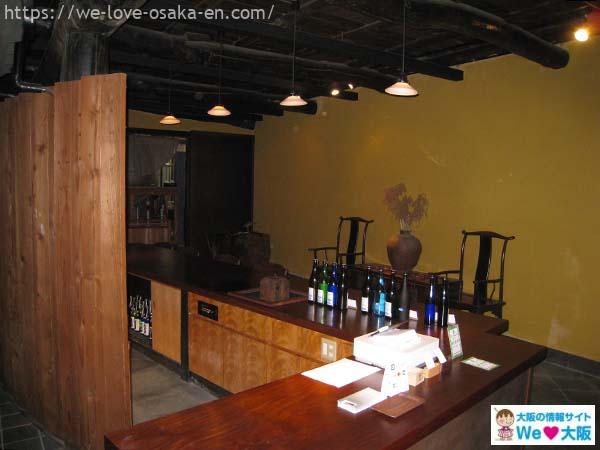 You can also buy sake that you did not try on the tour, so you might want to consult the staff. They will kindly answer your questions.
You can also buy sake that you did not try on the tour, so you might want to consult the staff. They will kindly answer your questions.
7.How you book a tour of the brewery
 You need to make a reservation for the tour of Daimon brewery, which you can do online. It is a paid tour, and it costs 1,500 yen each person.
You need to make a reservation for the tour of Daimon brewery, which you can do online. It is a paid tour, and it costs 1,500 yen each person.
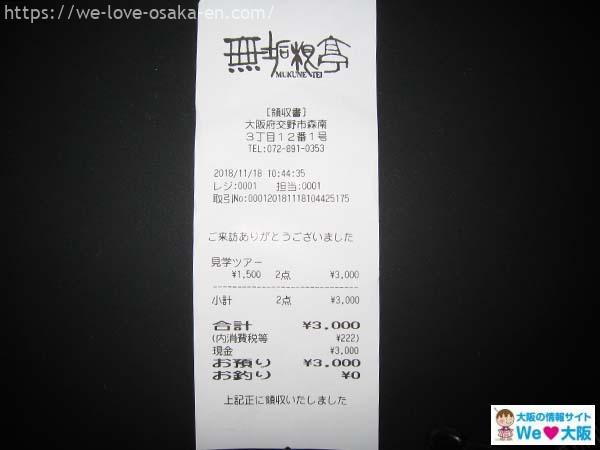 Click here to access to the web page where you can book a tour of Daimon brewery.
Click here to access to the web page where you can book a tour of Daimon brewery.
Scroll down to find “Reservation for Event/ Mukunetei/ Sake brewery tour” and click here.
You will see a monthly reservation table, so first determine the number of participants that will appear on the upper left, and then decide on the date. Click the date when you take part in the tour. You will be directed to the page where you can see its detail, so click on “proceed to reservation,” and fill out the form to book the tour. After you finish booking the tour, you will receive a confirmation e-mail from Daimon sake brewery.
Address:3-12-1 Moriminami, Katano City, Osaka, 576-0031
TEL:072-891-0353
E-mail:info@daimonbrewery.com
Hours:9:00-17:00
Holidays:Sundays and Mondays
Access:8 minutes on foot from Kawachimori Station on Keihan line, 7 minutes on foot from Kawachiiwafune Station on JR Gakkentoshi line
9.Summery
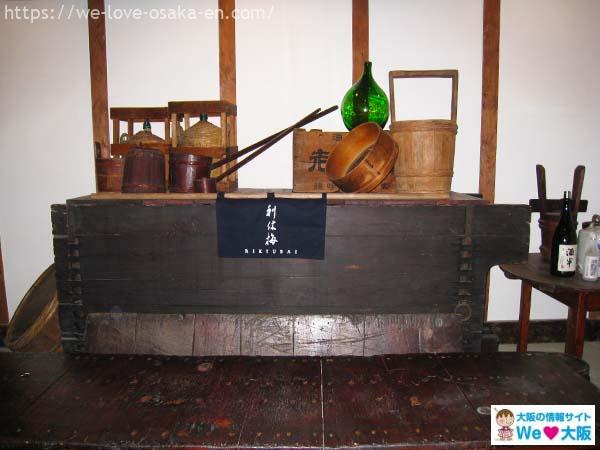 Japanese sake is getting popular all over the world. The number of people who want to see the places where Japanese sake is produced is increasing, and the tour of Japanese sake brewery is getting popular.
Japanese sake is getting popular all over the world. The number of people who want to see the places where Japanese sake is produced is increasing, and the tour of Japanese sake brewery is getting popular.
You can get to Kawachimori Station, which is the closest to the Brewery in 30 minutes if you take a limited express from Yodoyabashi and Kyobashi, and 8 minutes on foot from the nearest station. You will see a door on your left after you enter the gate. There is a reception here, and you have to book the tour here.
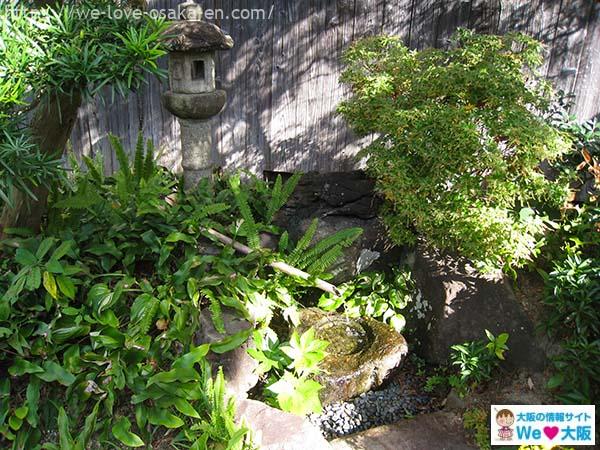 The sake brewery tour takes one hour, including the explanation of sake production, tour in the sake brewery, and tasting. The building has been renovated but it is very traditional as big pieces of wood are used for foists of the ceiling.
The sake brewery tour takes one hour, including the explanation of sake production, tour in the sake brewery, and tasting. The building has been renovated but it is very traditional as big pieces of wood are used for foists of the ceiling.
Men and women at various ages took part in the tour. I saw young women on the tour, because recently Japanese sake is very popular. You can try Japanese sake at the end. It is not just comparing different kinds of sake and see which one is your favorite and which one if your least favorite one, but you will taste each sake, judging each sake based on their sweetness, impression, and acidity.
So, it is not just “trying” each sake, but you will be “tasting” each sake. The participants chose different kinds of sake as their favorite. This is what is different from just “trying” sake.
The sake brewery tour has been popular among foreigners as Japanese sake is very popular all over the world now.
Why don’t you start going on sake brewery tours from here?
Related article
-
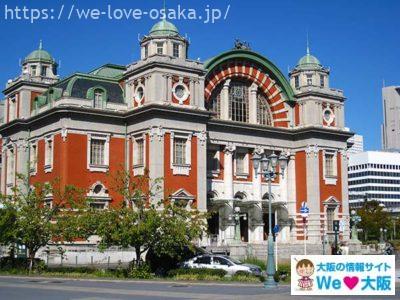
Osaka City Central Public Hall – A detailed guide to this retro landmark
Here is a special guided tour ……2023.03.20
-
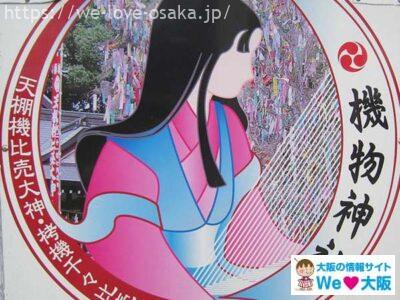
Hatamono Shrine- Birthplace of the Tanabata Legend and the Goddess Orihime
Hatamono Shrine enshrines Orih……2023.02.09
-
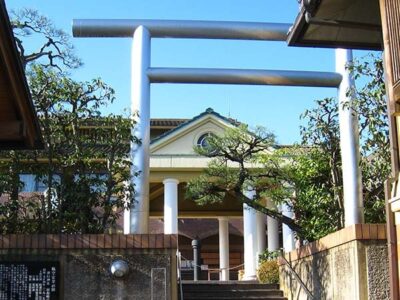
Hiko Shrine – Pray for a safe flight and fold your fortune into a paper airplane at “The Shrine of Flight”
Hiko Shrine translates as "The……2023.02.09









![┈ @大阪 お土産┈
《Baton d’or [バトンドール]》
/
もらうと嬉しい優勝プチギフト!
バター香る大人のお菓子💕
\
┈┈ ✧︎* 感想 ✧︎* ┈┈┈┈┈┈┈┈
ポッキーやビスコで有名な江崎グリコから出てる
百貨店限定のプレミアムスティック「バトンドール」🎗️
発酵バターと澄ましバターがふんだんに使われていて
袋を開けた瞬間に香るバターがたまらない🤤
サクッと食感も楽しめてさすがすぎる味わい…!
ポッキーのワンランク上のスイーツって感じで
友達へのお土産や手土産にピッタリ◎
オススメはコクのあるホワイトチョコレートと
いちごの甘酸っぱさが楽しめる【白いちご】だよ🍓🤍
┈┈ ✧︎* オススメポイント ✧︎* ┈┈┈┈┈
✔️Wバターのリッチな香り🧈🤍
✔️コンパクトサイズで手土産にピッタリ!
✔️ワンランク上のプチギフト🎁🎀
┈┈ ✧︎* m e n u ✧︎* ┈┈┈┈┈┈┈┈┈┈
🧈バトンドール(シュガーバター) ¥700
🍓バトンドール(白いちご) ¥700
┈┈ ✧︎* s h o p ✧︎* ┈┈┈┈┈┈┈┈┈┈
「Baton d’or [バトンドール]」
@batondor.official
■大阪府内(他の都道府県は公式HPをチェック!)
Baton d’or [バトンドール] 阪急うめだ本店
🕑10:00-20:00
📍大阪府大阪市北区角田町8-7
阪急うめだ本店 地下1階
Baton d’or [バトンドール] 髙島屋大阪店
🕑10:00-20:00
📍大阪府大阪市中央区難波5丁目1番5号
髙島屋大阪店 地下1階
Baton d’or [バトンドール] 大阪国際空港(伊丹空港)店
🕑 7:30-19:30
📍大阪府豊中市螢池西町3丁目555番地
大阪国際空港 ターミナルビル2F(関西旅日記内)
┈┈┈┈┈┈┈┈┈┈┈┈┈┈┈┈┈┈┈
🌐We love 大阪🌐とは…
“大阪好き”が本気でおすすめする体験型情報メディア。
他の投稿もチェックしてね!
@we_love_osaka_
┈┈┈┈┈┈┈┈┈┈┈┈┈┈┈┈┈┈┈
⚠️画像・動画の無断転載禁止です⚠️
#バトンドール
#お土産
#手土産
#大阪土産
#ポッキー](https://we-love-osaka-en.com/wp/wp-content/plugins/instagram-feed/img/placeholder.png)




